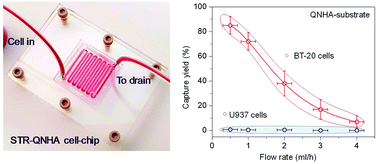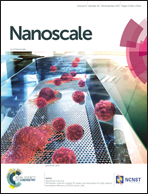Microfluidic channel-coupled 3D quartz nanohole arrays for high capture and release efficiency of BT20 cancer cells†
Abstract
Nanostructured materials, such as silicon nanowires, quartz nanostructures, and polymer-modified nanostructures, are a promising new class of materials for the capture and enumeration of very rare tumor cells, including circulating tumor cells (CTCs), to examine their biological characteristics in whole blood of cancer patients. These cells can then be used for transplantation, anti-tumor cell therapy, and cell-secreted protein studies. It is believed that 3-dimensional (3D) nanostructured substrates efficiently enhance cell capture yields due to the increased local contacts between the 3D nanostructures and extracellular extensions of the tumor cells. Recent studies have been performed with enhanced cell capture yields thanks to various nanostructured platforms; however, there remains an urgent need both to capture and release viable rare tumor cells for further molecular (i.e., protein) analysis and to develop patient-specific drugs. Here, we first demonstrate that our 3D quartz nanohole array (QNHA) tumor cell capture and release system allows us not only to selectively capture rare tumor cells, but also to release the cells with high capture and release rates. This system was developed using streptavidin (STR)-functionalized QNHA (STR-QNHA) with a microfluidic channel. Our system has ideal cell-separation yields of as high as 85–91% and high release rates of >90% for the BT20 cell line. We suggest that the use of a microfluidic channel technique coupled with a STR-QNHA cell capture and release chip (STR-QNHA cell chip) would be a powerful and simple process to evaluate the capture, enumeration, and release of CTCs from patient whole blood for studying further cell therapy and tumor-cell-secreted molecules.



 Please wait while we load your content...
Please wait while we load your content...